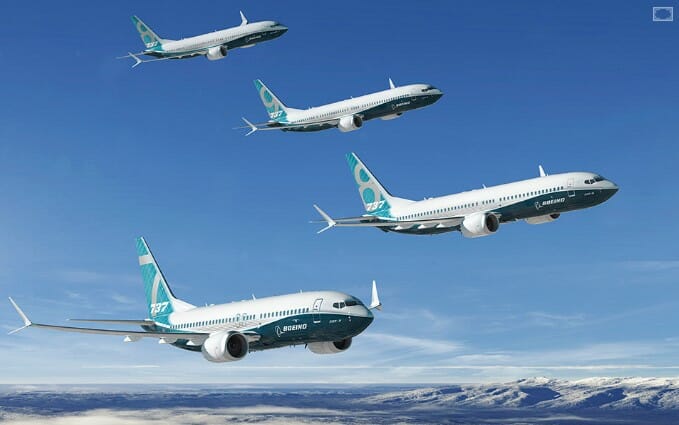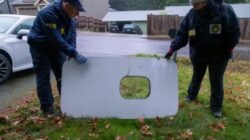It’s been 20 days since the plug door blew off of Alaska Airlines flight 1282. Since that day, the FAA has gone back and forth on how and when the Boeing 737 MAX9 would return to service. Since then, there have been finger-pointing and the blame game is in full swing. First today, the latest status from the FAA.
If you missed the previous posts on the 737 MAX9 door blowout, you can find them here:
- Part 1, What is a Boeing 737 MAX9 Door Plug That Failed? Why Is It There?
- Part 2, The “Nuts & Bolts” Of The Missing 737 MAX9 Plug Door
- Part 3, The 737 MAX9 Door Saga Continues. The FAA Wants Answers
- Part 4, Alaska Airlines CEO: Next Steps On The Boeing 737 MAX9
- Part 5, Boeing 737 MAX9 – FAA To Boeing: We’re Coming To Audit You
Updates on Grounding of Boeing 737 MAX 9 Aircraft
We do have a new update from the FAA yesterday outlining the plan to return the 737 MAX9 aircraft back to service. Here is the FAA bulletin from yesterday:
FAA Halts Boeing MAX Production Expansion to Improve Quality Control, Also Lays Out Extensive Inspection and Maintenance Process to Allow Boeing 737-9 MAX Aircraft to Return to Service
WASHINGTON – The Jan. 5 Boeing 737-9 MAX incident must never happen again. Accordingly, the Federal Aviation Administration (FAA) is announcing additional actions to ensure every aircraft is safe. The FAA today informed Boeing it will not grant any production expansion of the MAX, including the 737-9 MAX. This action comes on top of the FAA’s investigation and ramped up oversight of Boeing and its suppliers. The FAA today also approved a thorough inspection and maintenance process that must be performed on each of the grounded 171 Boeing 737-9 MAX aircraft. Upon successful completion, the aircraft will be eligible to return to service.
“We grounded the Boeing 737-9 MAX within hours of the incident over Portland and made clear this aircraft would not go back into service until it was safe,” FAA Administrator Mike Whitaker said. “The exhaustive, enhanced review our team completed after several weeks of information gathering gives me and the FAA confidence to proceed to the inspection and maintenance phase.
“However, let me be clear: This won’t be back to business as usual for Boeing. We will not agree to any request from Boeing for an expansion in production or approve additional production lines for the 737 MAX until we are satisfied that the quality control issues uncovered during this process are resolved.”
The FAA approved this detailed set of inspection and maintenance instructions after a thorough review of data from 40 inspections of grounded planes. The FAA also convened a Corrective Action Review Board (CARB). The CARB, made up of safety experts, scrutinized and approved the inspection and maintenance process.
Following the completion of the enhanced maintenance and inspection process on each aircraft, the door plugs on the 737-9 MAX will be in compliance with the original design which is safe to operate. This aircraft will not operate until the process is complete and compliance with the original design is confirmed.
The enhanced maintenance process will require:
- An inspection of specific bolts, guide tracks and fittings
- Detailed visual inspections of left and right mid-cabin exit door plugs and dozens of associated components
- Retorquing fasteners
- Correcting any damage or abnormal conditions
FAA ACTIONS TO HOLD BOEING ACCOUNTABLE TO THE HIGHEST STANDARD OF SAFETY:
After grounding the Boeing 737-9 MAX aircraft in early January, the FAA has laid out a series of actions to increase oversight of Boeing’s production lines.
“The quality assurance issues we have seen are unacceptable,” said Whitaker. “That is why we will have more boots on the ground closely scrutinizing and monitoring production and manufacturing activities.”
Increased oversight activities include:
- Capping expanded production of new Boeing 737 MAX aircraft to ensure accountability and full compliance with required quality control procedures.
- Launching an investigation scrutinizing Boeing’s compliance with manufacturing requirements. The FAA will use the full extent of its enforcement authority to ensure the company is held accountable for any non-compliance.
- Aggressively expanding oversight of new aircraft with increased floor presence at all Boeing facilities.
- Closely monitoring data to identify risk
- Launching an analysis of potential safety-focused reforms around quality control and delegation.
The FAA will continue to support the National Transportation Safety Board’s (NTSB) investigation into Alaska Airlines Flight 1282. The NTSB is in charge of the investigation and will provide any updates.
BOEING SAFETY REVIEW CULTURE REPORT (IN PROGRESS)
In early 2023, the FAA convened 24 experts to review Boeing’s safety management processes and how they affect Boeing’s safety culture. The FAA expects the report within weeks. The results of the Boeing Safety Culture Review report will also inform the agency regarding future action. The review panel included representatives from NASA, the FAA, labor unions, independent engineering experts, air carriers, manufacturers with delegated authority, legal experts and others. The panel has been reviewing thousands of documents, interviewed more than 250 Boeing employees, managers, and executives, Boeing supplier employees, and FAA employees and visited several Boeing sites as well as Spirit AeroSystems’ facility in Wichita.
737 MAX Production Rate
As I highlighted above, this FAA directive not only has a plan to return the MAX9 back to service but also makes a statement about the production rate. Currently, Boeing manufactures and delivers 31 737 MAX aircraft per month. They planned to increase the production rate in 2024 to 38 aircraft per month and to 50 aircraft per month beginning in 2025. Any increase in production rate will not happen until Boeing proves to the FAA that quality control is back on track and that Boeing is delivering safe aircraft.
Angry CEOs At United and Alaska Airlines
The customers are angry. United has 79 MAX9 aircraft and Alaska has 65 which have been grounded for nearly three weeks. The cost to an airline to cancel a single flight is costly. The costs to cancel over 100 flights per day is staggering. You can bet that both airlines’ accounting offices are keeping a tally of the costs to send a huge bill to Boeing to pay.
The fleet plan at United includes up to 150 737 MAX10 aircraft which still need airworthy certification from the FAA. United CEO Scott Kirby has decided that the future fleet plan will not include the MAX10. The airline will evaluate other aircraft along with delivery schedules before they make a decision. Alaska Airlines has 102 MAX10 on order and there is no comment so far as to any adjustments to their current order at this time. Alaska is more locked into a 737 fleet than at United Airlines. United also flies the 737 competitor, the Airbus A320 family of narrow-body aircraft.
Both CEOs are angry about the safety of the aircraft that Boeing is delivering to them. Alaska CEO Ben Minicucci is direct in his comments about the aircraft that Boeing is producing:
Alaska is an all-Boeing operator whose aircraft has emblazoned on the nose: “proudly all Boeing”. Both airline CEOs feel deeply let down by the quality failures at Boeing.
Safety Is A Culture
Anyone who has been in the military or flies for a living understands that safety is a culture. Safety is not a “box-checking exercise” to go through the motions. Safety is a culture that exists 24X7X365. Those adopting a proper safety culture find themselves living their private lives in the same safety culture that they do on the job.
Today, Boeing is having a “safety down day” today at the 737 factory. This is also another measure used by the military when multiple safety occurrences happen particularly when there is an accident or incident pattern. What does that mean? At the factory today, all production is halted. The employees will participate in various safety classes and presentations all day today.
In my previous posts, the fuselage is built in Wichita KS by Spirit AeroSystems and transported to Boeing in Renton WA by railcar. Boeing does the final assembly and completion of the aircraft. Spirit AeroSystems and Boeing have two different methods for inspection and quality control. Spirit AeroSystems uses a method called SAT, Situation Action Tracker. Boeing uses CMES which is Common Manufacturing Execution System. The problem goes beyond the fact that two different systems SAT and CMES are used, one system can’t access the other to cross-check each others work.
Boeing refers to individual safety quality issues as “safety escapements”. When you have repeated “safety escapements” this shows an overall problem with the safety cultures at both Spirit AeroSystems and Boeing.
It is known that the quality of fuselages coming from Spirit AeroSystems is problem-plagued. Spirit AeroSystems actually has employees stationed at the Boeing factory in Renton WA to rework quality issues before Boeing completes the final assembly of the airframes.
Was it Spirit or Boeing at fault in Alaska 1282?
We now have a better idea about the failure of Alaska Flight 1282. What we are learning is that the door seal gasket in the left side door plug (door L4) was installed incorrectly. In order to correct the door seal, the door must be opened but it doesn’t need to be removed. This is the key right here. The documented procedures for closing the door based on opening the door versus removing the door are different. Again, this goes back to Spirit using SAT and Boeing using CMES to inspect the completed work. There is a discrepancy in the inspection process where it is not needed to close a door plug that has been opened and not removed. This explains why Boeing inspectors failed to catch this lapse of workmanship. It is clear that none of the four bolts that hold the plug in place were replaced and nobody inspected the rework done by Spirit AeroSystems. You can bet that this lapse in oversight is going to change immediately.
Regarding the question of whether Spirit or Boeing is a fault, it is clear that both Companies are to blame.
Final Thoughts
Boeing has a lot to prove to the FAA, their airline customers and the flying public that their aircraft are airworthy and safe to fly. They need to cease having “quality escapements” and make significant changes to their safety culture and enforce a similar program at Spirit AeroSystems. Boeing can’t afford to have any more slipups in the 737 MAX program which could be the end of Boeing. These “safety escapements” will also delay the airworthy certification of the 737 MAX7 and 737 MAX10 aircraft by the FAA.





